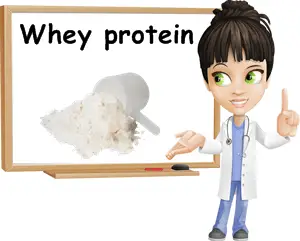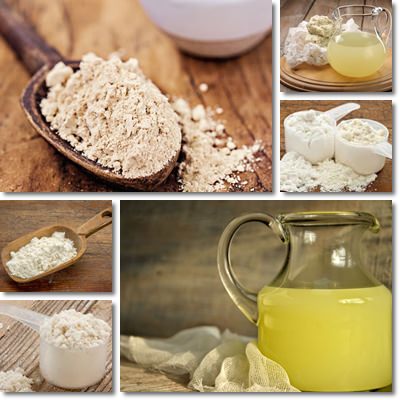Whey protein powder is probably one of the most sought-after natural protein sources nowadays.
Bodybuilders and virtually anyone who wishes to bulk up beautifully knows about the positive effects of whey protein.
From increasing muscle mass to promoting faster healing of muscle and connective tissue, weight loss, reduced cholesterol levels and body fat, whey protein promises to help improve our health in surprising ways.
Whey protein is obtained by extracting the proteins from liquid whey, a whitish, milky, liquid byproduct of cheese-making. In its natural form, whey is a generous source of important vitamins, dietary minerals and quality protein. In order to make the most of it, the proteins in it are extracted with as little fat and other components as possible, resulting in a concentrated, yet natural source of quality protein. Depending on the manner in which proteins are extracted and processed, there are four types of whey protein formulations.

Types of why protein
Concentrate whey protein
Concentrate is made by filtering liquid whey and drying it out to obtain whey protein. In addition to specific whey proteins, this formula also contains lactose and biologically active components. The downside is that protein content may vary from 30% to 80%. Whey concentrate also contains more calories (fats and carbohydrates) than other formulas, but considering that whey itself is low in calories, there are very few extra calories.
Isolate whey protein
This formula is obtained by isolating or filtering the proteins in whey, resulting in a pure whey protein product. Filtering and extracting whey proteins actually means that other components in whey such as fats or carbohydrates and other bioactive components are almost completely removed so the product has a high protein concentration (over 90%) and as few calories as possible.
Hydrolysate whey protein
Both concentrate and isolate whey protein can be hydrolyzed. In other words, manufacturers break the proteins into smaller particles (through exposure to acidic agents, heat or special enzymes) that are digested easier and thus reach the bloodstream faster. Whey protein concentrate and isolate are already fairly easy to digest and absorb, so hydrolyzed formulas may not make that much of a big difference.
Native whey protein
This formula is obtained from actual milk, not whey resulted from cheese-making. Depending on further extraction and processing methods, native whey can be turned into native whey isolate and native whey concentrate which can then be hydrolyzed.

What is whey protein made from?
Whey protein is a generic name for specific types of protein found in whey. In other words, whey protein is not a single protein, but a group of spherical proteins called globular proteins. Other bioactive compounds such as antibodies and enzymes are also found in liquid whey and whey protein, unless processed to inactivate them.
These are the 8 main components of whey and whey protein and their health benefits and other health effects:
Beta-lactoglobulin (about 65%)
This is the most abundant type of whey protein in cow and sheep milk and is responsible for some of the functional properties of whey, an example being water retention, as well as physiological benefits, notably positive effects on the immune system.
Alpha-lactalbumin (about 25%)
It is a globular protein found in the milk of most mammals and contains about 123 amino acids. It is often added to infant formulas to enrich them and make them more nutritionally similar to the mother’s milk.
Serum albumin (about 8%)
Serum albumin or blood albumin is another type of globular protein in whey. Serum albumins contain glutathione, a powerful antioxidant produced by our cells. Glutathione not only protects against free radical damage, but also helps repair DNA damage.
The antioxidant is involved in critical enzymatic reactions and amino acid transportation, supports the immune function and the nervous system and helps preserve dietary antioxidants (such as vitamin C) in their active, usable form. Lastly, glutathione exhibits a regulatory and neutralizing action against potentially harmful compounds such as hydrogen peroxide, nitrites, benzoates etc.
Secondary whey protein components (about 2%)
Lactoferrin
It is a type of globular protein found in milk, but also other secretions such as tears and saliva. Lactoferrin is found in human, cow, sheep and other animals’ colostrum (first milk) and boasts prebiotic properties and acts as a powerful immuno-stimulant.
Immunoglobulins
These large proteins serve as natural antibodies and are derived directly from the animal’s blood plasma. Immunoglobulins neutralize harmful foreign particles, bind them in order to make them a target for phagocytes (bacteria-eating antibodies) and promote inflammation at the site of infection.
Glycomacropeptides
As their name suggests, glycomacropeptides are larger protein peptides and derivates of casein, the most abundant protein in milk. They boast antiviral and antibacterial properties against E. coli and pathogenic Salmonella strains (source: Prevention of Intestinal Infection by Glycomacropeptide), reduce inflammation at the level of the digestive tract and boost immunity. Glycomacropeptides are also believed to improve the absorption of calcium.
Lactoperoxidase
It is an enzyme with natural bactericidal activity and immune-boosting properties. It has been shown to exhibit antibacterial activity at mucosal levels (examples include eye, ears nose, mouth and urethral mucosa).
Lysozyme
This enzyme is found in human and animal milk, mucus, saliva, tears as well as egg white and boasts strong antibacterial properties, especially against Gram-positive bacteria such as Bacillus and Streptococcus. Similar to the above-mentioned compounds with bactericidal effects, lysozyme destroys the cell walls of bacteria, leaving it exposed to macrophage action. Low lysozyme production may increase the risk of diarrhea, conjunctivitis and pulmonary disease in newborns.
What are the benefits of whey protein?
The most noticeable health benefits of whey protein consumption are:
High bioavailability
This basically means that whey proteins are absorbed fast and easy. This happens as a result of their highly bioavailable formulas, especially designed for fast and easy absorption.
Superior protein quality
Whey protein (and whey) contain all the essential amino acids our body requires in order to keep us healthy: leucine, isoleucine, valine, methionine, arginine, histidine, lysine, phenylalanine and tryptophan. This, in turn, engenders more complex health benefits for the nervous and muscular systems in particular.
Find out more about the health benefits of protein.
Muscle growth and athletic performance
Research confirms that increasing protein intake while on a rigorous workout regime can help build muscle mass and increase athletic performance. The reason is simple: protein favors muscle formation and repair.
More info on whey protein
Is whey protein healthy protein?
Whey protein in itself is a healthy, natural product. It is classified as a ‘dietary supplement’ because it supplements our body with a nutrient of great dietary importance: protein. If consumed according to recommendations, keeping to moderate intakes, whey protein can promote muscle fiber formation, relieve workout-related muscle aches, contribute to balanced eating, weight loss and many more protein-specific health benefits.
How to choose between protein brands
Make sure you choose quality products. Read the labels well, check protein content and search for any extra ingredients such as additional carbohydrates, fats, flavors or taste enhances etc. Go for the more natural products, with as few extra-ingredients as possible. It might also be best to avoid protein blends because you never really know how much whey protein and how much other types of protein you will actually get. Soy and fish protein are also found in most protein blends and are best avoided due to their not-so-balancing effects on our endocrine system (soy) and their high risk of heavy metal contamination (fish protein).
